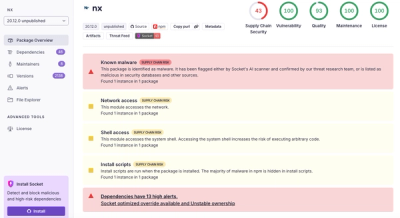
Security News
/Research
Wallet-Draining npm Package Impersonates Nodemailer to Hijack Crypto Transactions
Malicious npm package impersonates Nodemailer and drains wallets by hijacking crypto transactions across multiple blockchains.
@raisenow/paylink-button
Advanced tools
This component uses pnpm, so you need to install it first, if you don't have it yet.
Clone the repo:
git clone git@bitbucket.org:raisenow/paylink-button.git
Install dependencies:
pnpm install
pnpm start, pnpm devStarts dev server with hot reload.
pnpm build:<mode>Build the bundle with specified target mode.
Target modes:
devstageproductionpnpm serveLocally preview the build generated with build:dev command.
pnpm deploy:stageBuild the app with stage mode and upload it to the staging AWS S3 bucket.
npm publish --access publicMakes a new release on npm.
To use it on the page as a web component, add the following to the source code of your page:
<!--Example for stage environment-->
<script
src="https://paylink-button-stage.s3.eu-central-1.amazonaws.com/TwintButton.js"
type="module"
></script>
<twint-pay-button
solution-id="wpxdw"
language="en"
size="medium"
width="fixed"
color-scheme="dark"
></twint-pay-button>
In some cases it may be problematic to use web components, for example when you use not very modern CMS, which doesn't allow you to use custom tags.
In such cases it's possible to use initialisation script instead of web components.
To use it on the page with initialisation script, add the following to the source code of your page:
<!--Example for stage environment-->
<div id="rnw-twint-button"></div>
<script type="module">
import {TwintButton} from "https://paylink-button-stage.s3.eu-central-1.amazonaws.com/TwintButton.js"
TwintButton.render(
'#rnw-twint-button',
{
'solution-type': 'pay',
'solution-id': 'wpxdw',
'language': 'en',
'size': 'medium'
'width': 'fixed',
'color-scheme': 'dark',
}
)
</script>
<paylink-button><twint-pay-button><twint-donate-button>solution-typeType: string
Possible values: 'pay', 'donate'
Default value:
'pay' (in case of initialisation script usage)'pay' (in case of <twint-pay-button> web component usage)'donate' (in case of <twint-donate-button> web component usage)solution-idType: string
Default value: undefined (this is required attribute)
languageType: string
Possible values: 'en', 'de', 'fr', 'it', 'auto'
Default value: 'auto' (auto-detected based on user's browser language with a fallback to 'de' in case user uses unsupported language)
sizeType: string
Possible values: 'small', 'medium', 'large'
Default value: 'medium'
widthType: string
Possible values: 'fixed', 'full'
Default value: 'fixed'
color-schemeType: string
Possible values: 'dark', 'light'
Default value: 'light'
solution-idType: string
Default value: undefined (this is required attribute)
sizeType: string
Possible values: 'small', 'medium', 'large'
Default value: 'medium'
widthType: string
Possible values: 'fixed', 'dynamic', 'full'
Default value: 'fixed'
background-colorType: string
Default value: '#2596be'
labelType: string
Default value: 'Donate'
iconType: string
Possible values: 'gift', 'heart', 'secure'
Default value: 'gift'
border-radiusType: string
Default value: '8px'
Assuming you have <div id="rnw-twint-button"></div> container on your page,
Create button programmatically:
const button = document.createElement('twint-donate-button')
button.setAttribute('solution-id', 'wpxdw')
button.setAttribute('color-scheme', 'dark')
button.setAttribute('language', 'en')
document.querySelector('#rnw-twint-button').appendChild(button)
Change its attributes:
const button = document.querySelector('twint-donate-button')
button.setAttribute('color-scheme', 'light')
button.setAttribute('language', 'fr')
Assuming you have <div id="rnw-twint-button"></div> container on your page,
Create button programmatically:
<div id="rnw-twint-button"></div>
<script type="module">
import {TwintButton} from "https://paylink-button-stage.s3.eu-central-1.amazonaws.com/TwintButton.js"
TwintButton.render(
'#rnw-twint-button',
{
'solution-type': 'pay',
'solution-id': 'wpxdw',
'language': 'en',
'size': 'medium'
'width': 'fixed',
'color-scheme': 'dark',
}
)
</script>
Change its attributes (use the same TwintButton.render function on the same target):
<script type="module">
TwintButton.render('#rnw-twint-button', {
language: 'fr',
'color-scheme': 'light',
})
</script>
FAQs
Did you know?

Socket for GitHub automatically highlights issues in each pull request and monitors the health of all your open source dependencies. Discover the contents of your packages and block harmful activity before you install or update your dependencies.

Security News
/Research
Malicious npm package impersonates Nodemailer and drains wallets by hijacking crypto transactions across multiple blockchains.

Security News
This episode explores the hard problem of reachability analysis, from static analysis limits to handling dynamic languages and massive dependency trees.

Security News
/Research
Malicious Nx npm versions stole secrets and wallet info using AI CLI tools; Socket’s AI scanner detected the supply chain attack and flagged the malware.